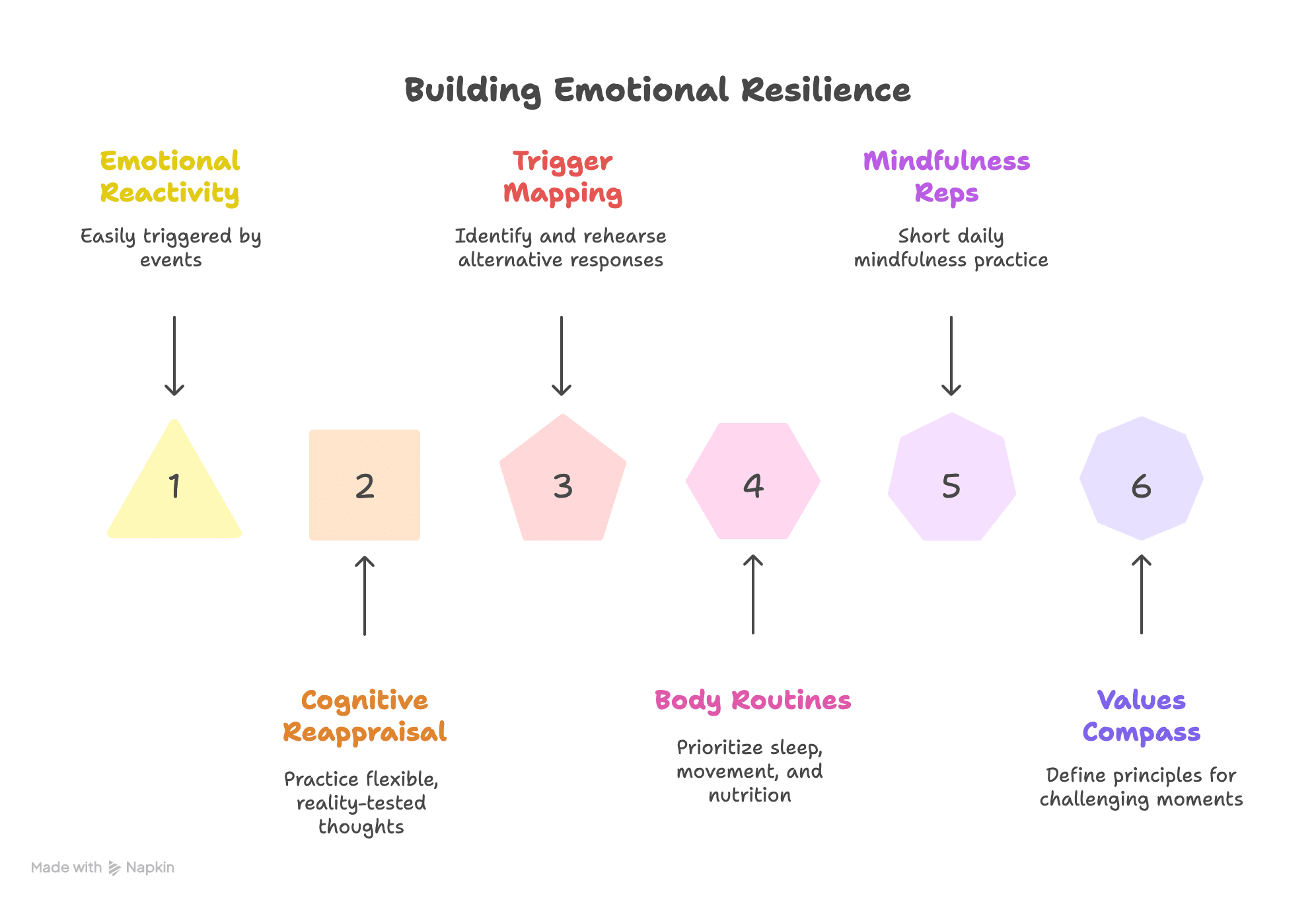Emotional Reactivity: What It Is (and Isn’t)
Purpose & Reader Promise
What you’ll get here: a plain‑language definition of emotional reactivity, a quick tour of how your body and brain drive fast reactions, and the three parts that shape it (sensitivity, intensity, persistence). You’ll leave with early warning signs you can spot in the moment and simple steps to start turning heat into clarity.
Quick Definition (Keep It Simple)
Emotional reactivity is how quickly strong feelings start, how big they get, and how long they stick around. Some people have a hair‑trigger alarm; others warm up slowly. Neither is “bad,” but high reactivity can lead to snap decisions, tense conversations, and stress on your health if it runs the show.
Emotional reactivity happens when we react impulsively to stress, anger, or hurt.
Researchers often measure reactivity with brief tools like the Emotion Reactivity Scale, which captures those three parts in one score. Reactivity also shows up early in life and may forecast later mood and stress challenges, which is one reason skills training matters (longitudinal evidence linking early reactivity to later outcomes).
How Your Body’s Alarm System Works (Plain English)
Your autonomic nervous system (ANS) has two big jobs: speed you up for action and settle you down after. When something feels risky—a sharp tone in a meeting, a text that reads cold—the “go” system floods the body: heart rate rises, muscles tense, thoughts narrow. On the other hand, the “brake” system helps you cool off and re‑open your attention.
Stress load, poor sleep, and even small daily hassles can tip the balance toward faster, hotter reactions. Stress lowers the ability to self-regulate emotions, making reactions more intense.
The Three Components
- Sensitivity: Feelings spark easily. Small triggers (a sigh, a delay) can light the fuse.
- Intensity: The reaction feels big in your body—tight chest, urge to fire off a message, tears close to the surface.
- Persistence: Feelings hang on longer than you want. You calm down, but the ember keeps glowing.
Recognizing triggers is an essential first step to understanding emotional reactivity.
Clinicians sometimes use structured scales to map these patterns so treatment can target what’s actually driving the heat.
Cognitive-Behavioral Therapy (CBT) and Dialectical Behavior Therapy (DBT) can teach practical skills for managing emotions, while psychodynamic therapy focuses on understanding the deeper patterns and past experiences that may be driving those feelings.
Quick self‑check:
- What triggers me most (tone, criticism, being ignored)?
- How big does it feel (0–10) in the first two minutes?
- How long until I’m back to baseline?
Spot the Signs (Mini Checklist)
- Body: racing heart, tight chest, flushed face, shaky hands.
- Thoughts: “This is a threat,” “They don’t respect me,” all‑or‑nothing conclusions.
- Behaviors: cutting someone off, firing off a text, going quiet/stonewalling.
- Patterns: small issues become big fights; dread before certain meetings; long mental replays after conflict.
In‑the‑Moment Playbook (2–5 Minutes)
- Pause your body: slow inhale–exhale cycle (counted breathing), loosen jaw/shoulders.
- Name it: pick a simple feeling word (angry, hurt, anxious). Naming reduces intensity.
- Ground: five‑senses scan (5‑4‑3‑2‑1) to re‑anchor attention.
- Buy time: “I need a minute to think. I’ll respond shortly.”
- Respond, don’t react: one clear sentence about your concern + one request.
Longer‑Term Skills (Build a Calmer Baseline)
- Cognitive reappraisal: practice flexible, reality‑tested thoughts; studies show that cognitive reappraisal can moderate the impact of emotional reactivity on symptoms over time.
- Trigger mapping: track top 3 triggers; rehearse alternative responses.
- Body routines: sleep, movement, caffeine/alcohol limits. Exercise, sleep, and nutrition are vital for emotional stability.
- Mindfulness reps: short daily reps beat rare long sessions.
- Values compass: pick 1–2 “how I want to show up” principles for hard moments.
Reactivity in Relationships (Keep Fights Small)
- Why little sparks turn into big fires: threat + misreading intent.
- “Rules of engagement” for partners and close coworkers:
- No interruptions; reflect back what you heard.
- Use timeouts (20–30 min) when flooded; always return.
- Repair early: 3 parts — acknowledge impact, share what you missed, state your next‑time plan.
When to Get Extra Support
- Signs it’s time: frequent blow‑ups, lingering shame after conflicts, reactivity affecting work or school, or feeling stuck despite trying. High reactivity can be linked with later internalizing problems in youth, especially under family stress. Unchecked emotional reactivity can amplify anxiety and reduce well-being.
- What therapy can teach: emotion labeling, reappraisal, distress‑tolerance, communication scripts, and relapse‑prevention plans.
- Therapy Group of DC: evidence‑based care, depth‑oriented insight, and practical skills; welcoming and inclusive.
Local Note (DC Context)
Many of our clients juggle high‑stakes roles (policy, law, tech, grad school). Therapy helps translate skills to real‑world moments: tense meetings, campus stress, and public‑facing work. A strong network of professional and personal relationships provides emotional support and a buffer against stress.
Looking to Take Action?
Curious whether high reactivity is getting in your way? Explore a first appointment with a DC therapist who can help you build steadier reactions and stronger relationships.
Frequently Asked Questions About Emotional Reactivity
What are common triggers of emotional reactivity?
Common triggers include external events that cause strong emotions such as criticism, feeling ignored, or unexpected changes. These triggering events can lead to intense emotional reactions and physiological responses like a racing heart or tight chest.
How can active listening help in reducing emotional reactivity?
Active listening allows you to fully understand the other person’s perspective without interrupting or making assumptions. By focusing on listening and asking clarifying questions, you can avoid misunderstandings that often lead to reacting impulsively and saying hurtful things.
What is an effective emotion regulation strategy to manage strong emotions?
One of the most effective ways is deep breathing or deep breath exercises. This promotes oxygen flow, helps release happy chemicals, and slows down physiological responses, enabling you to stay calm and respond thoughtfully rather than react strongly.
How does self-awareness contribute to less reactivity?
Self-awareness helps you recognize your physical symptoms and emotional experiences as they arise. By taking a mental note of feeling overwhelmed or triggered, you can pause and choose a more measured response, improving your mental health and well-being.
When should someone seek help from a therapist for emotional problems?
If emotional reactivity frequently leads to conflicts, lingering shame, or affects your relationships and daily functioning, it’s time to seek effective strategies through therapy. Therapists can guide you in developing skills like emotion regulation and communication to feel calm and manage intense emotions better.


